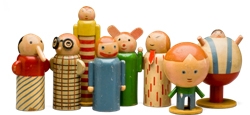Katarína Trnovská
The history of wooden toys can be traced back in Czechoslovakia to two distinct lines of production – both small and mass scaled. While Slovakia did not have the chance to exceed its own shadow of solitary traditional handicraft or artistic work, the Czech Republic became the leader of toy mass production which consequently promoted almost exclusively the ideas of Czech designers and artists.
The indigenous creations date back to the end of the 19th century, starting at a point when wooden toy production was almost entirely under private production; masters of the craft would create toys for the joys of their children and occasionally for annual fairs or markets to be sold along with furniture, tools, and utensils. However, fairly quickly the folk toys came into request by the typical urban customer. The growing demands required organized production. The Czechs became a power in the market, initially supplying to the Austro-Hungarian Empire and later spreading their works to other countries. The oldest history of wooden toys can be traced to the village of Jiřetín pod Bukovou, where in 1908 Johann Schowanek established the factory specialized in the manufacturing of mobile toys, wooden marbles, jewelry, and buttons. In the postwar years the factory succumbed to nationalization and was given the new name TOFA Semily. Wooden toys dated from that era reflect the change. Industrialization of agricultural production, the building of industrial plants, age of motors, and tourism were all topics that designers could translate thematically into the everyday playtime of children.
In Slovakian production, the making of toys was mostly reserved for gifting and small interior decorative objects. Line production was not utilized here at all.
